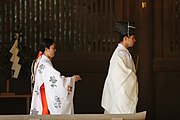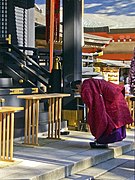Kannushi
 From Wikipedia the free encyclopedia
From Wikipedia the free encyclopedia
You can help expand this article with text translated from the corresponding article in Japanese. (January 2024) Click [show] for important translation instructions.
|
| Part of a series on |
| Shinto |
|---|
 |
A kannushi (神主, "divine master (of ceremonies)", originally pronounced kamunushi), also called shinshoku (神職, meaning "employee/worker of kami"), is a person responsible for the maintenance of a Shinto shrine (神社, jinja) as well as for leading worship of a given kami.[1] The characters for kannushi are sometimes also read as jinshu with the same meaning.
History[edit]
Originally, the kannushi were intermediaries between kami and people and could transmit their will to common humans.[2] A kannushi was a man capable of miracles or a holy man who, because of his practice of purificatory rites, was able to work as a medium for a kami. Later the term evolved to being synonymous with shinshoku - a man who works at a shrine and holds religious ceremonies there.[1][3]
In ancient times, because of the overlap of political and religious power within a clan, it was the head of the clan who led the clansmen during religious functions, or else it could be another official.[3] Later, the role evolved into a separate and more specialized form. The term appears in both the Kojiki (680 AD) and Nihon Shoki (720 AD),[3] where the Empress Jingū and Emperor Sujin respectively become kannushi.[2]
Description[edit]
Within the same shrine, such as at Ise Jingū or Ōmiwa Shrine, there can be different types of kannushi at the same time; these may be called, for example, Ō-kannushi (大神主), Sō-kannushi (総神主), or Gon-kannushi (権神主).[2][3] Kannushi are assisted in their religious or clerical work by women called miko.
Kannushi can marry, and their children usually inherit their position.[4] Although this hereditary status is no longer legally granted, it continues in practice.[5]
Vestments and ritual objects[edit]
The clothes kannushi wear, such as the jōe, the eboshi and kariginu, do not have any special religious significance, but are simply official garments previously used by the Imperial court.[4] This detail reveals the close connection between kami worship and the figure of the Emperor.[4] Other implements used by kannushi include a baton called shaku and a wand decorated with white paper streamers (shide) called ōnusa.
- A kannushi in full dress, Katori Shrine
- A kannushi wearing a kariginu and an eboshi hat
Education[edit]
To become a kannushi, a novice must study at a university approved by the Association of Shinto Shrines (神社本庁, Jinja Honchō), typically Tokyo's Kokugakuin University or Ise's Kogakkan University, or pass an exam that will certify his qualification.[5] Women can also become kannushi, and widows can succeed their husbands in their job.[5]
Onshi[edit]
An Onshi or Oshi (御師) is a lower level Shinto priest analogous to a deacon or an acolyte. They are considered between a layperson and clergy.
See also[edit]
References[edit]
- ^ a b * Kannushi (in Japanese), Iwanami Kōjien (広辞苑) Japanese dictionary, 6th Edition (2008), DVD version
- ^ a b c Nishimuta, Takao (2007-03-28). "Kannushi". Encyclopedia of Shinto. Kokugakuin. Retrieved 2009-10-16.
- ^ a b c d Moriyasu, Jin. "Kannushi". Nihon Hyakka Zensho (in Japanese). Shogakukan. Archived from the original on 2012-09-14. Retrieved 2009-10-16.
- ^ a b c Nishimura, Hajime (1998). A Comparative History of Ideas. Motilal Banarsidass. ISBN 978-81-208-1004-4.
- ^ a b c "Shinshoku". Encyclopædia Britannica Online. Retrieved 2009-10-16.
External links[edit]
- Kannushi, Encyclopedia of Shinto


